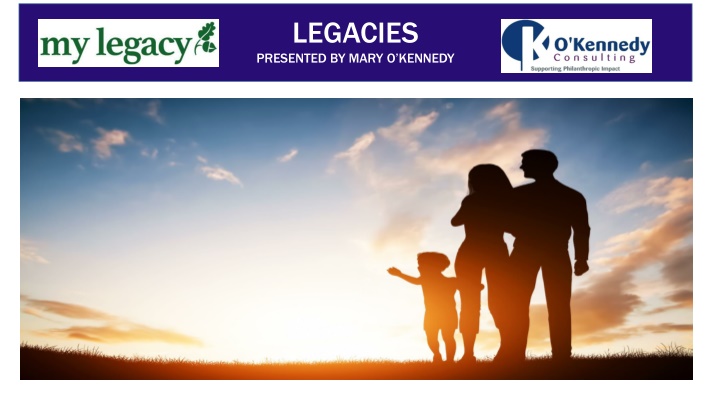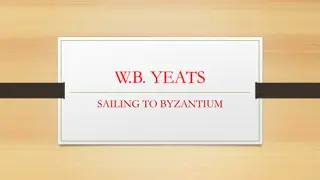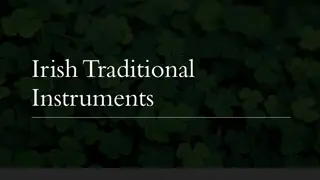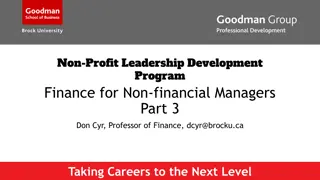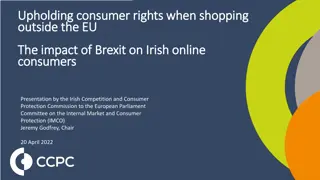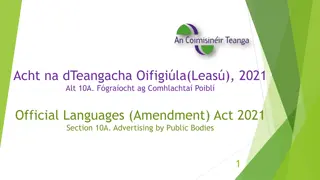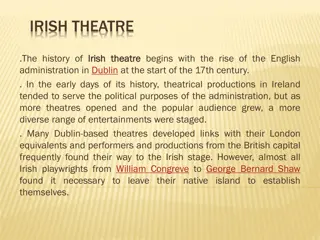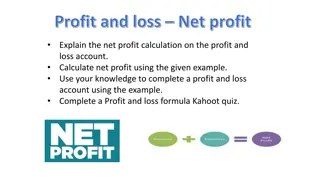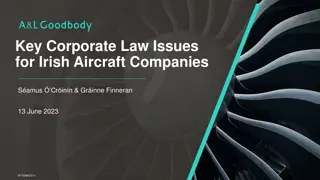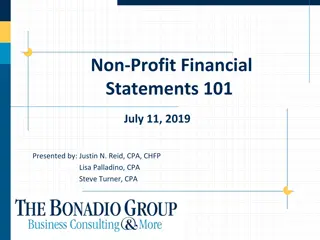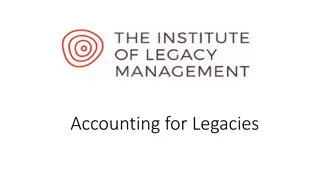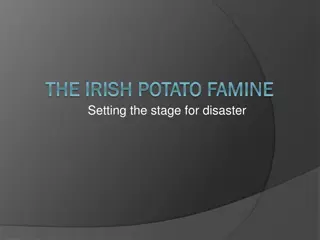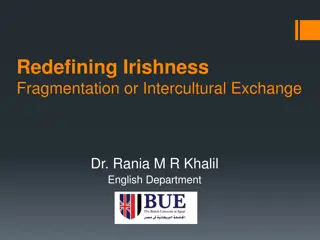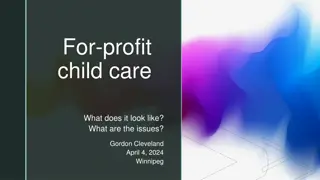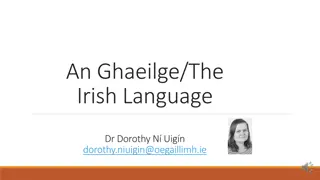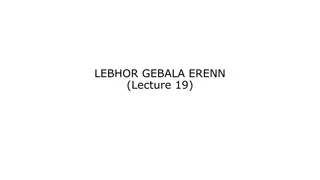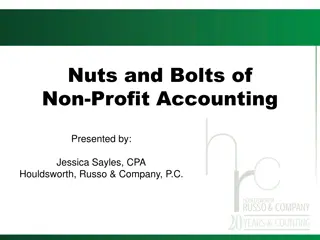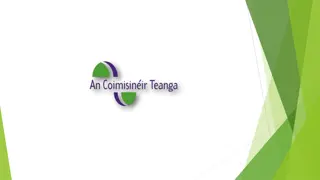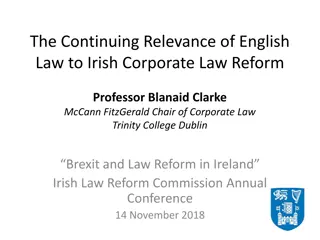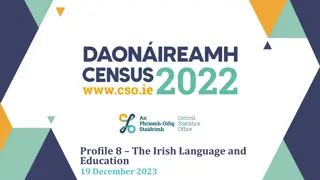Insights into the Irish Non-Profit Sector: Funding Disparities and Impactful Legacies
Irish non-profit sector faces funding inequities with a majority directed at major charities, leaving smaller organizations underserved. Boards are predominantly older men, and pay norms are below average. A remarkable legacy story of Elizabeth O. Kelly, who generously bequeathed 30 million to charities posthumously, reflecting humility and dedication to volunteer work.
Download Presentation

Please find below an Image/Link to download the presentation.
The content on the website is provided AS IS for your information and personal use only. It may not be sold, licensed, or shared on other websites without obtaining consent from the author.If you encounter any issues during the download, it is possible that the publisher has removed the file from their server.
You are allowed to download the files provided on this website for personal or commercial use, subject to the condition that they are used lawfully. All files are the property of their respective owners.
The content on the website is provided AS IS for your information and personal use only. It may not be sold, licensed, or shared on other websites without obtaining consent from the author.
E N D
Presentation Transcript
LEGACIES PRESENTED BY MARY O KENNEDY
SECTOR OVERVIEW SECTOR OVERVIEW in 100 ORGANISATIONS! in 100 ORGANISATIONS!
Irish NFP Sector Irish NFP Sector Fewer than 300 NFPs have a turnover greater than 5m, with more than 3,000 reporting a turnover of 50,000 or less. State funding is not evenly distributed - 4.2bn, or more than 70% of public money committed to the NFP sector is directed at only 60 major charities for which data is available 22 higher education bodies, and 38 health or social care services, on behalf of the State. Most of the remaining 1.7bn goes to c.1,500 NFPs about half of which are registered charities that derive more than 50% of their funding from the State. About half of these smaller NFPS were established between 2000 and 2010, often as special purpose vehicles to provide job creation, local development, social supports and other arms length services on behalf of the State. The rest were set up independently of Government to provide services mostly in health and social services, local development, housing and advocacy.
Irish NFP Sector Irish NFP Sector The average size of a NFP Board is 6 directors/charity trustees mostly older men. Nearly a quarter have served on the same board for nine years or more. These trends are most pronounced in the boards of sports bodies (where the male:female balance is 80:20, and one-third of directors/trustees have served for more than nine years), and in social enterprise and social housing. The Report debunks the impression that NFP employees are highly paid. Outside of the higher education and Section 38 where staff are remunerated as though they were public servants, Third Sector pay norms fall well below the average in the rest of the economy, with fewer than 1% of jobs attracting higher pay (more than 70,000 per annum). More than 80,000 people served as directors and/or trustees in Irish NFPs during 2018. This figure does not include the many thousands of people who serve on the Boards of Management committees of clubs and societies. See https://en.benefacts.ie/2019/04/17/benefacts-latest-third-sector-analysis/
A LEGACY DONOR A LEGACY DONOR
WHAT A LASTING LEGACY !! WHAT A LASTING LEGACY !! A LEGACY STORY - ELIZABETH O KELLY The late widow bequeathed 30 million to five charities 6 million each to the Irish Cancer Society, Irish Heart Foundation, Irish Kidney Association, the Irish Society for Autism and the Royal National Lifeboat Institution (RNLI) after her death in December 2016 at the age of 92. She was a very simple, very humble, no-fuss lady. She didn t parade her wealth or grandeur in any way. She didn t ever present herself as a millionaire or anything like that, Fr. Sean Kelly The RNLI said it was deeply grateful and humbled by the generosity of Ms O Kelly, who for many years volunteered her time to help out at the RNLI stall at the RDS in Dublin. She held a high regard for the charity s volunteer work, which appealed to her ethos, a spokesperson for the RNLI said. The 6 million donation to the Irish Cancer Society alone was the largest donation ever received by the charity, and the equivalent of two annual Daffodil Day fundraising efforts. Ms O Kelly had first-hand knowledge of the work carried out by the charity. She survived a battle with cancer in the 1980s
Legacy giving in Ireland: An Overview Research on Irish legacy giving (Persuasion Republic & My Legacy): Legacy income accounted for 11% of voluntary income over the period 2012-2014 (based on cumulative totals over the three years) Income increased by 10.7m over 45% year on year between 2015 and 2016. Increases were seen in every sector of the sample except Housing, Homelessness and Anti-poverty where it declined by 13%. A significant factor in the increase was due to TCD which received 2.7m in bequests in 2016 up from 540,000 in 2015. ISPCA also recorded a major increase raising from 238,692 to 809,800.
Legacy giving in Ireland: An Overview Over the six year period (2012 2017, in the 20 organisations sampled by Persuasion Republic/My Legacy, legacy income varied hugely - From 18.8m in 2012 it declined to as little as 11.08m in 2015 and then rose to 25.8m in 2017 BUT 13m of the total 98.3m was received in just two gifts 7m to Barrettstown in 2012 and 6m to Irish Cancer Society in 2017 (only one of the EOK chosen 5 charities that received 6m each in 2017 is included in the sample of 20). Number of bequests varied from 599 to 706 per year BUT the number of bequests received per year bears no relationship to the amount of income received. For example, in 2017 the year with the lowest number of bequests (599), the largest amount of legacy income was generated (25.8m). The Overseas Aid sector which accounts for 40% of the income accounts for 51% of the bequests. It is the most predicable sector with income averaging 6 7m per year. It had a particularly good year in 2017 receiving over 10m. General donations to this sector declined in this period.
Legacy Giving in Ireland: An Overview Of the sample group of 20, the top three causes that received the most legacy income over the period 2012-2017 were; Overseas aid ( 43,740,597) sample of 6 Health, hospices and hospitals ( 22,536,885) sample of 5 Children s charities ( 12,616,906) sample of 3
Legacy giving in Ireland: An Overview In nearly all cases, the average values of residuary bequests were significantly higher than pecuniary. The average residuary values ranged from 4 to 5 times higher in most cases to over 100 times higher in one case. The number of bequests received per year bears no relationship to the amount of income received. For example, in 2017 the year with the lowest number of bequests (599), the largest amount of legacy income was generated (25.8m). The Overseas Aid sector which accounts for 40% of the income accounts for 51% of the bequests.
Legacy giving in Ireland: An Overview Reponses to questions on legacy administration revealed that: 44% of respondents had a legacy pledge programme in place 26% had an In Memoriam programme in place and 19% had both a legacy pledge programme and an In Memoriam programme in place. Just under one third of respondents had a partnership with legacy advisors (i.e. solicitors, accountants and financial/wealth advisers).
Legacy giving in Ireland: An Overview 24 organisations surveyed on marketing/admin Most organisations (18) have legacy promotion programmes in place and 16 for more than one year. Legacy pledge programmes are less common with only 11 organisations having one, of these only 5 hold legacy pledge events. Targeting solicitors and financial advisors with promotional campaigns is undertaken by less than half the sample, (only 9), and only 6 have partnerships with legacy advisors. The vast majority of organisations spend little or nothing on legacy promotion 6 spend nothing, 12 spend less than 3% . Only 4 organisations spend between 10-25%.
LEGACIES: Types of gifts LEGACIES: Types of gifts
Legacy fundraising: key Legacy fundraising: key features features Income from legacies is usually (or ideally!) unrestricted Legacies can be comparatively cheap to raise Legacy gifts may be pecuniary (gifts of a specific sum) Legacy gifts may be residuary gifts (gifts of the balance of the estate after specific legacies and debts have been paid Legacy gifts can be non-monetary e.g. property/jewellery (specific legacy)
Legacy fundraising: key Legacy fundraising: key features features Legacy fundraising is regarded as the last great fundraising opportunities!! We plod around the opportunity as if we were undertakers ourselves ..We need to admit its joy, its promise, its inherent customer satisfaction. It is the only donation that just about everyone can make. (Smith) #GivingAfterLiving v #GivingWhileLiving!
Legacy fundraising: why leave a Legacy fundraising: why leave a planned gift? planned gift? Reasons why donors leave legacies: Desire to support the charity (97%) The ultimate use of the gift by the charity (82%) Desire to reduce taxes (35%) Long range estate and financial planning issues (35%) Create a lasting memorial for self or loved one (33%) Relationship with a representative of a charity (21%) Encouragement of family and friends(13%) Encouragement of legal or financial advisers (12%) Source: NCPG
Legacy fundraising: will making Legacy fundraising: will making The key main reasons why an individual will make a will are: Illness of the individual Death of a relative Difficulties associated with having to sort out the estate of a family member Some form of family change e.g. marriage, children, divorce Planning long distance travel Purchase of a house
Legacy fundraising: will making Legacy fundraising: will making Some of the main barriers to making a will: A belief there would be nothing to leave The absence of anyone obvious to leave things to A feeling that it was morbid to think about death Had not yet got around to it Did not expect to die for some time Too difficult to sort out their affairs
Research on role of solicitors and donor behaviour Research on role of solicitors and donor behaviour A research study* showed that when a solicitor said many of our clients like to leave money to charity in their will. Are there causes you are passionate about? led to 15.4% of people to leave a gift. When asked Would you like to leave any money to charity in your will? 10.8% left a gift. When the solicitor did not ask 4.9% of people left a gift. *Source: Trial 5: Helping people commit to donate money to charity through their wills http://good2give.ngo/wp- content/uploads/2016/04/CAF_Charitable_Giving_Report_May_2013.pdf (Page 22)
Research on legacy giving: key findings Research on legacy giving: key findings The will making process can shape whether people leave money to charity in their will 46% of respondents said that solicitors had a duty to ask clients about legacy giving The specific language used around will making can make a substantial difference to whether people left money to charity social norm framing, emotional framing and posthumous benefit framing
Social norm framing Social norm framing Telling people that charitable bequests is something that people do George Hamilton This worked well for people writing their wills for the first time The group who were told this donated 40% more than the group who were not told this This type of message discouraged people who were revising existing wills
Emotional framing Emotional framing Asked clients to think about charities that they or their families care about or have benefitted from This was the only type of message that increased donations from clients both with and without children
Posthumous framing Referring to the good work that would result from a charitable bequest This had a consistently negative effect compared to other types of messaging The survey confirmed that people felt this language was the least acceptable of the three message frames Source: http://www.rememberacharity.org.uk/wp-content/uploads/Legacy- Giving-Report-_2016-Executive-Summary.pdf
Exchange of Values: access Exchange of Values: access Exchange of Values Exchange of Values Rosen, Key Points Rosen, Key Points Solicitors and Wealth Advisors may be able to enable access to their clients, by, for example, sharing a charity s literature in its offices. Charities might be able to offer access to their supporters by inviting the solicitor to speak at events or attend networking dinners. Of course, access to both groups would have to be offered with careful consideration of data protection and stewarding donor/client trust.
Exchange of Values: publicity Exchange of Values: publicity Charities may be able to offer publicity to solicitors and advisers, perhaps through appropriate sponsorship opportunities. Similarly, solicitors could offer publicity to charities, perhaps through a story in a client newsletter.
Exchange of Values: credibility Exchange of Values: credibility Association with a well-respected and well-known charity can offer credibility to a solicitor/adviser, whilst working with advisers can offer credibility to charities. For example, an article about writing a will or structuring gifts is likely to be perceived as more credible coming from a legal expert rather than the charity themselves
Exchange of Values: The Bottom Line Exchange of Values: The Bottom Line Generally, solicitors don t make a profit on writing wills, but on acting as executors. They may be inclined to support charitable will making schemes as a way of building business for the future and by making wills for charitably-minded people, and ensuring that they prompt them about the possibility of including a legacy gift, they can potentially grow income for charities at the same time
Exchange of Values: free advice Exchange of Values: free advice Friendly solicitors might be able to offer legal advice to a charity perhaps if there are any complicated legalities surrounding a gift. However, charities might also be able to offer useful advice, whether on their own organisation specifically, or about different ways of giving more generally.
Exchange of Values: philanthropy Although, there are obviously a range of potential business benefits for advisers in working with charities, we shouldn t forget that many solicitors are likely to also be philanthropically-minded and to derive a sense of personal satisfaction from working with charities that they have a connection to, or that benefit their local communities.
Exchange of Values: Summary Exchange of Values: Summary So, like all good fundraising, Rosen s exchanges show us that, when seeking to develop relationships with solicitors, we should start from their perspective. By working through his exchanges of value, we can focus on the potential benefits to our solicitor partners, as well as to our organisations developing relationships that add value to them, us, our donors, and ultimately, and most importantly, the causes that we serve. Dr Claire Routley Rosen s Exchange of Values
The Future! The Future! According to the recent Community Foundation for Ireland report, Legacies for Good by Jim O Leary, 122- 185bn could be left in wills and transferred between generations over the next 20 years. If charitable bequests were to account for a similar percentage as in the UK our current legacy income would amount to 220m per year, a figure that could rise to the 380- 560m range by 2036.
Recommended reading Anything Stephen George has shared/written on the subject! How to Love Your Donors (To Death) - S Pidgeon Fundraising Planning and Management - (Sargeant and Jay) Donor Centred Planned Gift Marketing - M Rosen Richard Radcliffe Interesting Reads!
